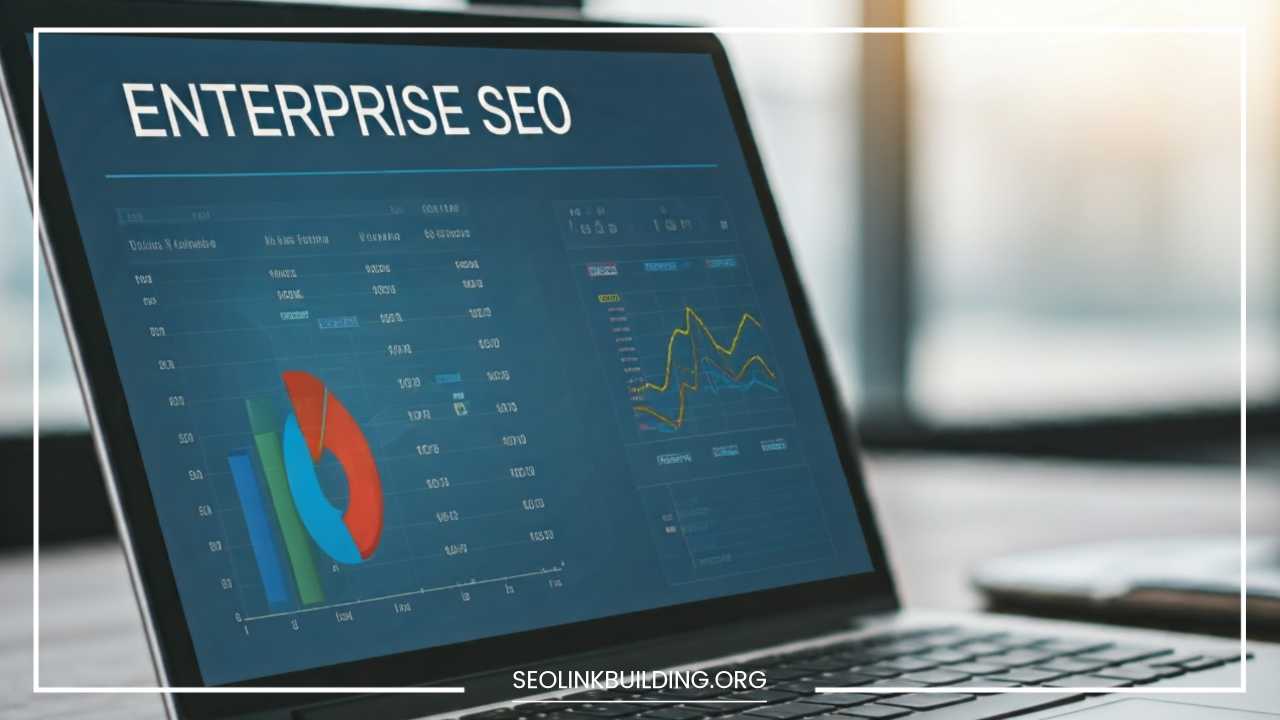Enterprise SEO Strategies For Maximum Growth

Enterprise SEO Strategies
Comprehensive Guide to Enterprise SEO Strategies
Enterprise SEO is a specialized field within search engine optimization tailored to the unique needs of large-scale organizations.
This approach goes beyond traditional SEO, employing a comprehensive strategy that encompasses technical optimization, content creation, link building, and user experience to enhance organic visibility and drive substantial growth.
Enterprise SEO is designed to handle complex website structures, extensive content repositories, and broad business objectives, ensuring that large organizations achieve significant and sustainable online success.
Understanding Enterprise SEO
Enterprise SEO differs from traditional SEO in several crucial ways:
1. Scale and Complexity
Enterprise websites are typically vast and intricate, often featuring multiple subdomains, extensive content libraries, and complex navigational structures.
This scale requires advanced SEO tools and strategies to manage and optimize effectively. Unlike smaller sites, enterprise websites must handle issues related to site architecture, crawl budget, and content duplication, necessitating a more sophisticated approach to SEO.
2. Broader Goals
While traditional SEO primarily focuses on increasing organic traffic, enterprise SEO encompasses a wider range of objectives.
These include enhancing brand reputation, improving conversion rates, supporting overarching business goals, and contributing to market expansion.
Enterprise SEO efforts are aligned with broader organizational goals, making them integral to overall business success.
3. Team Structure and Collaboration
Enterprise SEO typically involves a dedicated team of professionals, including SEO specialists, content marketers, developers, analysts, and sometimes external consultants.
This team collaborates to tackle the multifaceted challenges associated with large-scale SEO efforts. Effective communication and coordination between different departments are essential for achieving cohesive and successful SEO strategies.
Key Strategies for Enterprise SEO Success
1. Comprehensive Keyword Research
1.1 Identify Relevant Keywords
Effective keyword research is foundational to any SEO strategy, and for enterprise SEO, it involves a more extensive approach.
Utilize advanced tools like Google Keyword Planner, SEMrush, and Ahrefs to uncover a broad spectrum of keywords that align with your business objectives.
Consider not only high-volume and low-competition keywords but also niche terms that could drive qualified traffic to your site.
Develop a keyword list that covers various aspects of your business, including products, services, and industry-related topics.
1.2 Understand User Intent
Understanding user intent is crucial for creating content that resonates with your audience. Analyze search queries to determine the underlying motivations and needs of users.
This involves categorizing keywords based on the stages of the customer journey—such as awareness, consideration, and decision.
Tailor your content to address these specific needs, ensuring that it aligns with what users are searching for and provides valuable solutions.
1.3 Target Long-Tail Keywords
Long-tail keywords, while less frequently searched individually, can be highly effective in attracting targeted traffic.
These keywords are often more specific and have lower competition, making it easier to rank for them. For enterprise websites, targeting long-tail keywords can help capture niche markets and address specific user queries that broader keywords might miss.
Incorporate long-tail keywords into your content strategy to improve your chances of ranking for highly relevant search terms.
2. Technical SEO Optimization
2.1 Conduct a Comprehensive Website Audit
A thorough technical audit is essential for identifying and addressing issues that could impact your SEO performance.
Use tools like Screaming Frog, Sitebulb, or DeepCrawl to perform detailed audits and detect issues such as broken links, slow page load times, and duplicate content.
Prioritize fixes based on their impact on user experience and SEO performance. Regular audits help ensure that your website remains in optimal condition and can effectively support your SEO efforts.
2.2 Ensure Mobile Optimization
With the increasing use of mobile devices, mobile optimization is critical for both user experience and SEO.
Ensure that your website is mobile-friendly by employing responsive design techniques, which adapt the layout and functionality of your site to different screen sizes.
Additionally, optimize mobile page speed to enhance user satisfaction and support Google’s mobile-first indexing. Use tools like Google’s Mobile-Friendly Test to evaluate and improve your mobile site’s performance.
2.3 Create and Maintain an XML Sitemap
An XML sitemap is a valuable tool for helping search engines crawl and index your site more efficiently. For enterprise websites with complex structures and multiple subdomains, maintaining an up-to-date XML sitemap is crucial.
Ensure that your sitemap reflects new content and changes to your site’s structure. Regularly submit your sitemap to search engines via tools like Google Search Console to facilitate better indexing.
2.4 Implement Schema Markup
Schema markup provides search engines with additional context about your content, potentially enhancing your visibility in search results through rich snippets.
Implement schema for various types of content, such as articles, reviews, products, and events, to improve the likelihood of appearing in rich results.
Use schema.org to find relevant markup types and integrate them into your website’s code to provide search engines with more detailed information about your content.
3. High-Quality Content Creation
3.1 Develop a Strategic Content Plan
A well-defined content strategy is essential for aligning your content efforts with business goals. Develop a comprehensive content plan that includes a content calendar, topic clusters, and targeted formats.
Identify key themes and topics that resonate with your target audience and support your SEO objectives. Consider creating a mix of content types, including blog posts, whitepapers, case studies, videos, and infographics, to engage different segments of your audience.
3.2 Create Valuable and Engaging Content
High-quality content that addresses user needs and provides genuine value is key to driving engagement and improving SEO performance.
Focus on producing content that is informative, engaging, and actionable. Ensure that your content is well-researched, thoroughly edited, and visually appealing.
Incorporate multimedia elements, such as images and videos, to enhance the user experience and make your content more engaging.
3.3 Optimize Content for SEO
Incorporate relevant keywords naturally into your content to improve its search engine visibility. Optimize meta descriptions, title tags, and header tags to ensure that they accurately reflect the content and include targeted keywords.
Additionally, use internal linking to connect related content and provide a logical structure for both users and search engines. Optimize images with descriptive alt text and ensure that your content is easily readable and accessible.
3.4 Promote Content Effectively
Promote your content through various channels to maximize its reach and impact. Utilize social media platforms, email marketing, and partnerships with industry influencers to drive traffic to your content.
Engage with your audience through comments, shares, and discussions to foster a sense of community and encourage further interaction with your content.
Consider leveraging paid promotion, such as social media ads or sponsored content, to amplify your content’s visibility and reach.
4. Robust Link Building
4.1 Analyze Your Backlink Profile
Regularly analyze your backlink profile to assess the quality and relevance of the links pointing to your site. Use tools like Ahrefs, Moz, or SEMrush to evaluate the strength of your backlinks and identify opportunities for improvement.
Pay attention to metrics such as domain authority, anchor text distribution, and link placement. Address any toxic or low-quality links that could harm your SEO efforts by using tools like Disavow Links in Google Search Console.
4.2 Focus on Quality Over Quantity
When building backlinks, prioritize quality over quantity. Aim to acquire links from reputable and relevant websites within your industry.
High-quality backlinks from authoritative sources have a more significant impact on your search rankings and overall credibility.
Avoid tactics that focus on accumulating a large number of low-quality links, as these can have a negative impact on your SEO performance.
4.3 Leverage Guest Posting
Guest posting is an effective way to build valuable backlinks and enhance your brand’s visibility. Identify reputable industry publications and blogs that accept guest contributions and offer to write high-quality, relevant articles for them.
Ensure that the publications are authoritative and have a strong readership. Guest posting not only helps with link building but also positions your brand as a thought leader within your industry.
4.4 Utilize Broken Link Building
Broken link building involves finding broken links on other websites and offering to replace them with links to your own relevant content. Use tools like Broken Link Checker or Ahrefs to identify broken links on industry-related sites.
Reach out to webmasters with a well-crafted pitch offering your content as a replacement. This strategy helps improve the user experience on other sites while providing valuable backlinks to your own site.
5. User Experience Optimization
5.1 Enhance Website Usability
Ensuring that your website provides a positive user experience is essential for retaining visitors and improving SEO performance. Focus on usability by designing intuitive navigation, clear calls-to-action, and user-friendly interfaces.
Conduct user testing to identify any usability issues and make necessary improvements. A well-designed website that prioritizes user needs can lead to increased engagement, lower bounce rates, and higher conversion rates.
5.2 Optimize Page Load Speed
Page load speed is a critical factor for both user satisfaction and SEO. Slow-loading pages can negatively impact user experience and search engine rankings.
Optimize your site’s performance by compressing images, leveraging browser caching, and minimizing code. Use tools like Google PageSpeed Insights or GTmetrix to identify and address speed-related issues. Aim for a fast-loading website to enhance user experience and support your SEO goals.
5.3 Adopt a Mobile-First Design Approach
With the increasing number of mobile users, adopting a mobile-first design approach is crucial. Ensure that your website delivers an optimal experience on mobile devices by designing with mobile users in mind.
This involves creating a responsive design that adapts to different screen sizes and optimizing mobile page speed.
Google’s mobile-first indexing means that your mobile site’s performance directly affects your overall search rankings.
5.4 Optimize Site Architecture
Creating a logical and intuitive site architecture is essential for both user experience and SEO. Organize your site’s structure with clear hierarchies and well-defined categories to help users find the information they need easily.
Use internal linking to connect related content and provide a logical path for users to follow. A well-structured site architecture also aids search engines in crawling and indexing your content effectively.
6. Analytics and Measurement
6.1 Track Key SEO Metrics
Monitoring key SEO metrics is essential for evaluating the effectiveness of your SEO efforts and making data-driven decisions.
Track metrics such as organic traffic, keyword rankings, conversion rates, and user behavior to gauge the impact of your strategies. Use tools like Google Analytics, Google Search Console, and SEMrush to collect and analyze data.
Regularly review your metrics to identify trends, successes, and areas for improvement.
6.2 Provide Regular Reports
Providing regular reports to stakeholders is important for demonstrating the value of your SEO initiatives and ensuring alignment with business objectives.
Use data to highlight successes, address challenges, and make informed decisions about future strategies. Present your findings in a clear and concise manner, focusing on key metrics and actionable insights.
Regular reporting helps maintain transparency and accountability within your organization.
6.3 Conduct A/B Testing
A/B testing is a valuable method for optimizing your website’s performance and conversion rates. Experiment with different elements of your site, such as headlines, calls-to-action, and layouts, to determine which variations perform best.
Use tools like Google Optimize or Optimizely to conduct A/B tests and analyze the results. Implement changes based on test findings to enhance user engagement and drive better outcomes.
7. Enterprise SEO Tools and Technology
7.1 Utilize Enterprise-Level SEO Platforms
Leverage enterprise-level SEO platforms to streamline and optimize your SEO efforts. Tools like BrightEdge, SEMrush, and Moz offer advanced features for keyword research, site audits, and performance tracking.
These platforms provide comprehensive insights and data to help you manage large-scale SEO initiatives effectively. Invest in the right tools to support your enterprise SEO strategies and enhance your overall performance.
7.2 Choose the Right Content Management System (CMS)
Selecting a CMS that supports SEO best practices is crucial for managing your content and optimizing your site. Choose a CMS that allows for easy optimization of meta tags, URL structures, and other SEO elements.
Ensure that the CMS supports customizability and scalability to accommodate your enterprise website’s needs. Popular CMS options for enterprise sites include WordPress, Drupal, and Sitecore.
7.3 Use Analytics Tools for Performance Tracking
Utilize analytics tools to track and analyze website performance and user behavior. Tools like Google Analytics and Adobe Analytics provide valuable insights into how users interact with your site and help inform your SEO and content strategies.
Set up custom dashboards and reports to monitor key metrics and make data-driven decisions. Regularly review your analytics data to identify opportunities for optimization and improvement.
Challenges and Considerations
1. Scale and Complexity
Managing an enterprise website’s scale and complexity presents unique challenges. Large sites with multiple subdomains and extensive content require sophisticated strategies and tools to ensure effective SEO management.
Addressing issues related to site structure, crawl budget, and content duplication is crucial for maintaining optimal SEO performance.
Developing a scalable SEO strategy that can adapt to the evolving needs of your enterprise website is essential.
2. Overcoming Internal Silos
Overcoming internal silos and fostering collaboration between different departments is essential for successful enterprise SEO.
Coordinate with teams across marketing, IT, content, and other departments to ensure alignment and address any barriers that may impact SEO efforts.
Establish clear communication channels and collaborative processes to facilitate effective teamwork and drive cohesive SEO strategies.
3. Maintaining Technical Expertise
Maintaining technical expertise is vital for navigating the complexities of enterprise SEO. Stay updated with the latest SEO best practices, algorithm changes, and emerging technologies to ensure that your strategies remain effective and competitive.
Invest in ongoing training and professional development for your SEO team to keep up with industry advancements and maintain a high level of technical proficiency.
4. Committing to Long-Term Efforts
Enterprise SEO requires a long-term commitment and consistent effort to achieve meaningful results. Unlike short-term tactics, enterprise SEO involves ongoing optimization, content creation, and performance monitoring to drive sustained growth and success.
Set realistic goals and expectations, and be prepared to invest time and resources into developing and executing a comprehensive SEO strategy.
Final Thoughts
Implementing effective enterprise SEO strategies is crucial for optimizing your online presence, enhancing organic visibility, and achieving your business goals.
By focusing on comprehensive keyword research, technical SEO optimization, high-quality content creation, robust link building, user experience optimization, and leveraging advanced tools and technology, enterprise organizations can drive substantial and sustainable growth.
Addressing challenges related to scale, complexity, internal collaboration, and technical expertise is essential for successful enterprise SEO.
With a strategic and well-coordinated approach, large organizations can overcome these obstacles and achieve significant results in their SEO efforts.
Enterprise SEO is a dynamic and multifaceted field that requires ongoing commitment, adaptability, and a focus on delivering value to both users and search engines.
By implementing these strategies and continuously refining your approach, you can effectively manage and optimize your enterprise website, drive organic traffic, and achieve long-term success in the competitive digital landscape.













